
Collective of Southern Artists was accused of making fun of the Christian faith, leading to a complaint being lodged against them by Christian Lawyers Foundation. It was stated that the organization presented crucifixes along with dolls and weapons.
Lawsuit Against Collective of Southern Artists
A report from the Catholic News Agency stated that the display of crucifixes fashioned with doll heads was the basis for the legal action. The crucifixion victim was depicted in the pieces as being equipped with a gun in his left hand while carrying a banknote in his right hand.
A group of artists is being investigated for "the possible existence of a criminal offense" against religious sensibilities after an order was issued by Trial Court No. 6 in Fuenlabrada, Spain. The ruling mandated that initial procedures be begun into the matter.
As mentioned, one of the items that prompted the filing of the criminal charge included an item that looks like a confessional, and there is an offensive representation of a priest inside it.
Ana Antón, a member of Christian Lawyers and the attorney in charge of the case praised the judgment made by the court. "We are fed up with the fact that where the Left governs, these types of attacks are financed with public money, which are also a crime. We are not going to allow it," he noted.
Also Read: The Church Is The Key To Overturning The Electoral Deceit And Mockery Of God In America
Christian Art
Based on an article from Press Books, early Christian art, also known as Paleochristian art, was created by Christians or through the guidance of Believers from the early time of Christianity until, depending on the term employed, between the years 260 and 525. The earliest examples of art identified as Christian date back to the second century. After 550, Christian art is categorized as Byzantine or another type entirely, depending on the region.
However, it can be challenging to pinpoint the exact beginning of art that may be identified as Christian. Before the year 100, Christians were possibly prevented from producing long-lasting works of art due to their status as a persecuted group.
On the other hand, since people of lower social classes predominantly practiced Christianity during this time, the absence of art that has survived may be due to a lack of funding opportunities or a small number of adherents.
In the act of strategic and tactical convergence, the early Christians borrowed Roman themes to provide new meanings to symbols that had previously been associated with pagan religion. The peacock, grapevines, and the "Good Shepherd" image were some of the used patterns. Additionally, early Christians established their very own style of iconography. Certain symbols, like the fish (ikhthus), were not taken from the iconography of pagan religions.
As per Cobo Social, although there are works of art depicting Jesus that deliberately seek to cause controversy, there are also works that accidentally do so. Artists, in both instances, give Christians and non-Christians a fascinating lens through which to examine their ideas and, at times, expand what an icon of culture like the Christian church can signify in general.
Occasionally, people assume that artists are merely attempting the Christian doctrine of forgiveness, a test of sorts for tolerance. Furthermore, there is no doubt about it since Jesus has been at the center of many controversies in the art world.
Related Article:‘Guardians Of The Galaxy’ Director James Gunn Defends Chris Pratt From Those Mocking His Christian Faith


















